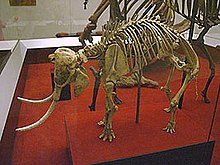Mammuthus creticus
| Mammuthus creticus Temporal range:
| |
|---|---|

| |
| Skeleton in the Netherlands | |

| |
| Drawing of the teeth | |
| Scientific classification | |
| Domain: | Eukaryota |
| Kingdom: | Animalia |
| Phylum: | Chordata |
| Class: | Mammalia |
| Order: | Proboscidea |
| Family: | Elephantidae |
| Genus: | †Mammuthus |
| Species: | †M. creticus
|
| Binomial name | |
| †Mammuthus creticus (Bate, 1907)
| |
| Synonyms | |
|
Elephas creticus Bate, 1907 | |
Mammuthus creticus, or the Cretan dwarf mammoth, is an extinct species of dwarf mammoth endemic to Crete. It is only known from a single locality near Chania, which probably dates to the Early or Middle Pleistocene.[1] With a shoulder height of about 1 metre (3.3 ft) and a weight of about 180 kilograms (400 lb),[2] it was the smallest mammoth that ever existed.[3] Its size reduction was the result of insular dwarfism, where the body size of large mammals on islands reduces as the result of decreased food availability, predation and competition.[3] It was originally described as Elephas creticus by Dorothea Bate in 1907. After DNA research published in 2006, it was proposed to rename Elephas creticus into Mammuthus creticus (Bate, 1907).[4] Others proposed (in 2002)[5] to rename all the described specimens of larger size under the new subspecies name Elephas antiquus creutzburgi (Kuss, 1965). A 2007 study criticised the results of the 2006 DNA study, showing that the DNA research was likely flawed.[6] However, morphological data supports a placement in Mammuthus.[3][1] It probably derived from Mammuthus meridionalis, or less likely, Mammuthus rumanus.[3] It was one of only three mammal species native to Crete during the Early Pleistocene and the early Middle Pleistocene, alongside the dwarf hippopotamus Hippopotamus creutzburgi and the giant rat Kritimys.[1]
See also
- Dwarf elephant
- Mammuthus lamarmorai a dwarf mammoth species known from the Middle-Late Pleistocene of Sardinia
- Mammuthus exilis a dwarf mammoth native to the Channel Islands off the coast of California during the Late Pleistocene
References
- ^ a b c Lyras, George A.; Athanassiou, Athanassios; van der Geer, Alexandra A. E. (2022), Vlachos, Evangelos (ed.), "The Fossil Record of Insular Endemic Mammals from Greece", Fossil Vertebrates of Greece Vol. 2, Cham: Springer International Publishing, pp. 661–701, doi:10.1007/978-3-030-68442-6_25, ISBN 978-3-030-68441-9, retrieved 2023-02-19
- ^ Larramendi, A. (2016). "Shoulder height, body mass and shape of proboscideans" (PDF). Acta Palaeontologica Polonica. 61. doi:10.4202/app.00136.2014.
- ^ a b c d Herridge, V. L.; Lister, A. M. (2012). "Extreme insular dwarfism evolved in a mammoth". Proceedings of the Royal Society B: Biological Sciences. 279 (1741): 3193. doi:10.1098/rspb.2012.0671. PMC 3385739. PMID 22572206.
- ^ Poulakakis, N.; Parmakelis, A.; Lymberakis, P.; Mylonas, M.; Zouros, E.; Reese, D. S.; Glaberman, S.; Caccone, A. (2006). "Ancient DNA forces reconsideration of evolutionary history of Mediterranean pygmy elephantids". Biology Letters. 2 (3): 451–454. doi:10.1098/rsbl.2006.0467. PMC 1686204. PMID 17148428.
- ^ Poulakakis, Nikos; Mylonas, Moysis; Lymberakis, Petros; Fassoulas, Charalampos (2002). "Origin and taxonomy of the fossil elephants of the island of Crete (Greece): problems and perspectives". Palaeogeography, Palaeoclimatology, Palaeoecology. Elsevier BV. 186 (1–2): 163–183. doi:10.1016/s0031-0182(02)00451-0. ISSN 0031-0182.
- ^ Orlando, L.; Pagés, M.; Calvignac, S.; et al. (2007-02-22). "Does the 43bp sequence from an 800000 year old Cretan dwarf elephantid really rewrite the textbook on mammoths?". Biology Letters. 3 (1): 57–59. doi:10.1098/rsbl.2006.0536. PMC 2373798. PMID 17443966.